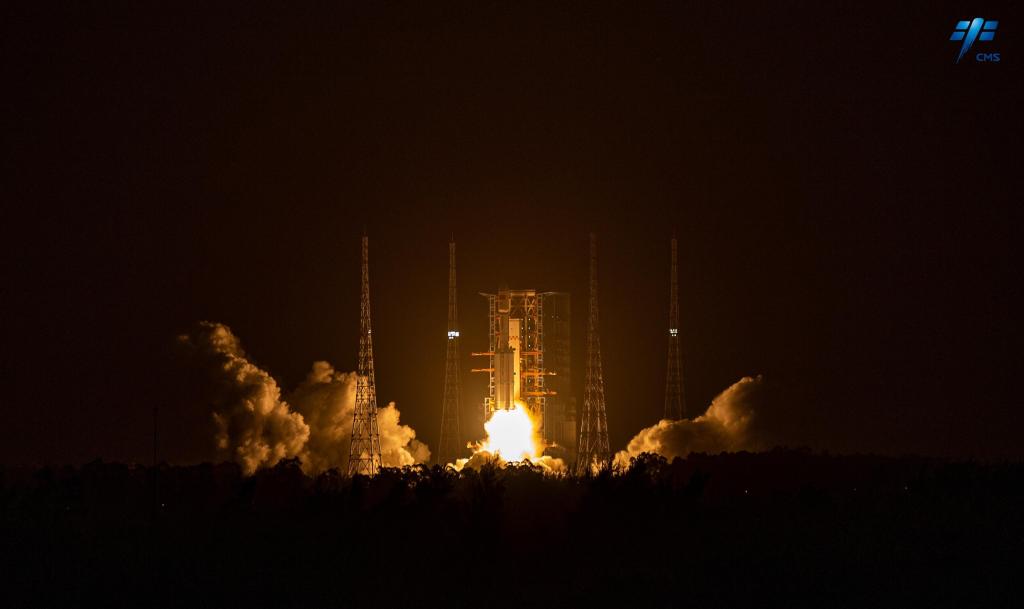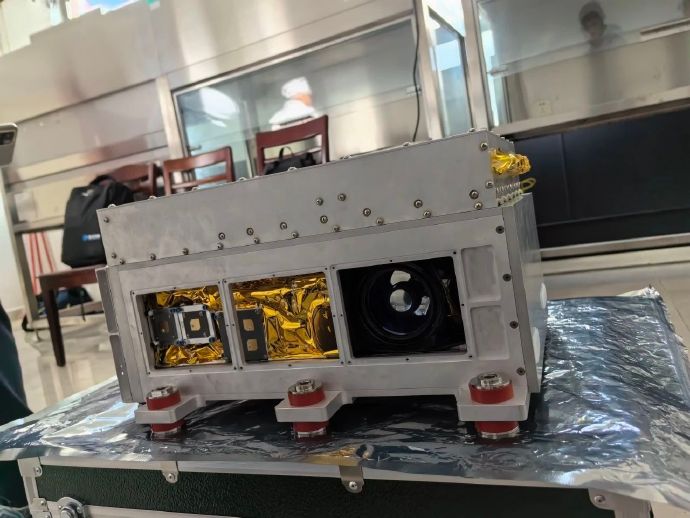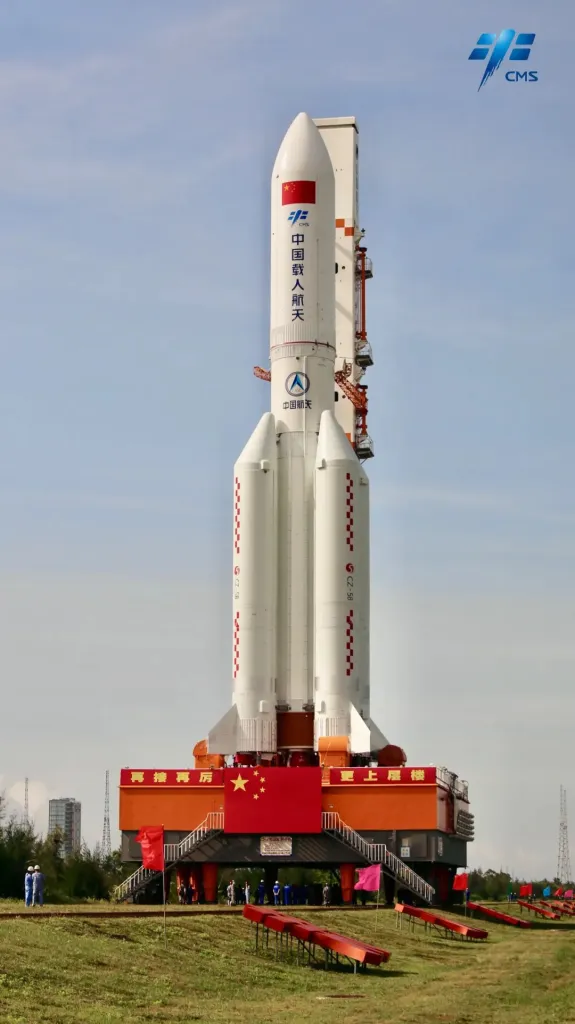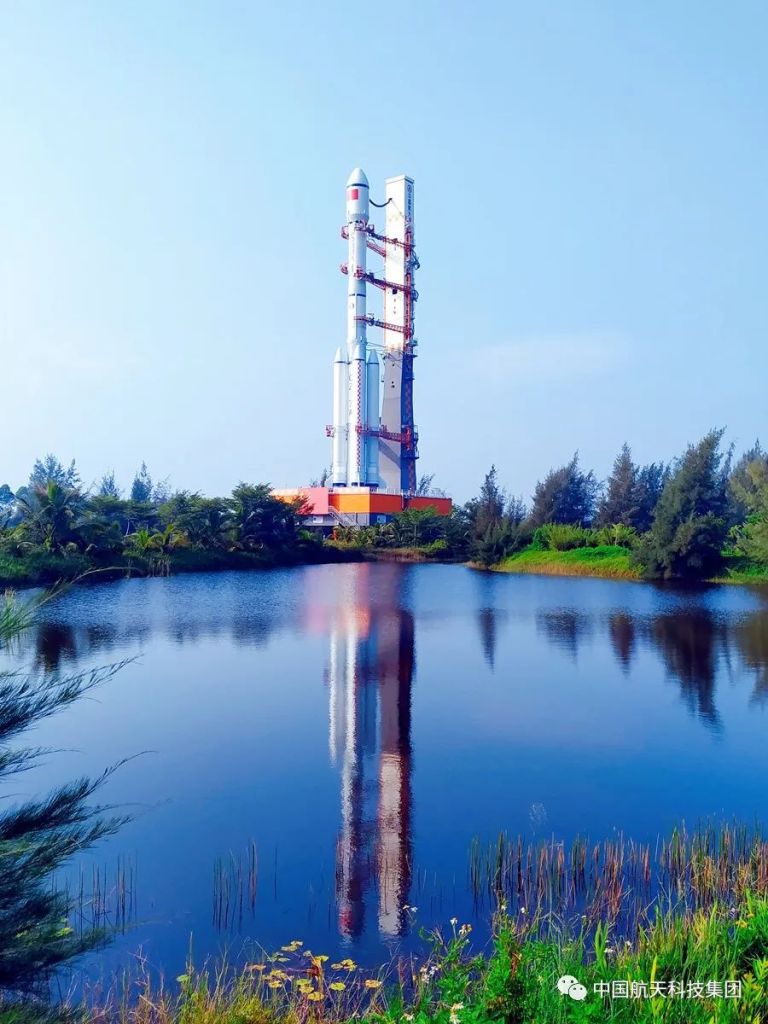Featured image credit: Xinhua
Liftoff Time | January 17, 2024 – 14:27:23 UTC | 22:27:23 BJT |
|---|---|
Mission Name | Tianzhou-7 (TZ-7), a resupply mission supporting Tiangong, the China Space Station (CSS) |
Launch Provider | China Aerospace Science and Technology Corporation (CASC) |
Customer | China Manned Space Agency (CMSA) |
Rocket | Long March 7 Y8 (CZ-7 Y8) |
Launch Location | LC-201, Wenchang Space Launch Site, in the Hainan island, China |
Payload mass | About 11,750 kg (~25,900 lb) |
Where did the spacecraft go? | To the Tiangong station, in a circular low-Earth orbit (LEO) of 388 km (~240 mi) altitude and 41.5 degrees inclination; initially, 201×324 km (~125×200 mi) x 41.47° |
Did they attempt to recover the first stage? | No, the Long March 7 is not capable of stage recovery |
Where did the first stage land? | Both the side boosters and the first stage crashed into the South China Sea |
Did they attempt to recover the fairings? | No, the Long March 7 is not capable of fairing recovery |
Were these fairings new? | Yes |
This was the: | – 507th launch of a rocket of the Long March family – 31st launch of China Manned Program – 13th orbital launch attempt of 2024 – 5th Chinese launch of 2024 – 14th launch of a rocket of the Long March 7 family overall – 1st launch of a rocket of the Long March 7 family of 2024 – 8th launch of the Long March 7 overall – 1st launch of the Long March 7 of 2024 |
Where to re-watch | Official replay with English commentary |
What’s All This Mean?
The China Aerospace Science and Technology Corporation (CASC) — the main contractor working in the Chinese space program — is ready to launch the Tianzhou-7 mission for the China Manned Space Agency (CMSA) aboard a Long March 7 rocket with serial number Y8. Lifting off from Wenchang, at Hainan Island in China, the launcher will inject the cargo spacecraft into an initial orbit.
From there, the Tianzhou freighter will raise itself to meet the China Space Station (CSS), Tiangong. After completing its approach, the spacecraft plans to dock to the Tianhe module.
How Did It Go?
The rocket lifted off on time, taking to the skies on the thrust of its engines. They required the manual triggering of their ignition system, though this was not a sign of an anomaly. During the flight, the launch vehicle nominally went through all the expected milestones. Finally, Tianzhou-7 separated from the second stage and extended its solar panels. The announcement of launch success came shortly afterward. Later, at about 17:46 UTC, the spacecraft docked to the CSS.
What Is The Tianzhou-7 Mission?
Chinese missions, such as Tianzhou-7, are logistics flights in support of Tiangong, deploying Tianzhou spacecraft with cargo. Through them, the China Manned Space (CMS) program is able to send supplies to the orbiting lab and its crew. Similarly, this is what happens with commercial resupply missions for NASA — using Dragons or Cygnuses — or Progress missions from Roscosmos. All of them play their role in keeping the International Space Station (ISS) running, while Tianzhou flights do the same regarding the CSS.
Cargo on Tianzhou-7
In spite of the station’s current stock of supplies — enough for another three months in orbit — Tianzhou-7 will provide further replenishment. That is, Tiangong will have sufficient provisions for the taikonauts of both Shenzhou-17 and Shenzhou-18 missions to carry out their tasks. Among many other items, this mission brings 90 kg (~200 lb) of fruit for the crew in the station. Additionally, it carries 1,750 kg (~3,900 lb) of propellant for the CSS, as well as spare parts, experiments, and more food. The total cargo mass amounts to about between 5,600 kg (~12,300 lb) and 5,700 kg (~12,600 lb).
DO NOT PUBLISH. In the case of the seventh Tianzhou capsule launching toward China’s station, the following items — massing a total of ~X,XXX kg (~XX,XXX lb) — are flying in its cargo compartments:
- Propellant: 1,750 kg (~3,900 lb)
- 700 kg (~1,600 lb) will refill Tiangong’s tanks.
- Xenon, for electric propulsion: 160 kg (~360 lb)
- Food
- Fruits: 70 kg (~160 lb)
- Water
- Clothing
- 98 items for 29 experiments: 714 kg (~1,600 lb).
- These included payloads, equipment, consumables, samples, and spare parts. Said experiments cover areas like space medicine, biotechnology, combustion physics, material science, fluid mechanics in microgravity, among others.
Furthermore, at least one very small satellite travels on this mission, with the cargo vessel deploying it at some point after launch.
Nanjing Or Bayi-08
The students of the Nanjing Vocational Institute of Mechatronic Technology, a college specializing in that field, developed this spacecraft. Known both as Nanjing, and Bayi-08, it is part of a program to promote space sciences. The National Defense Science and Technology Bureau (NDSTB) and the China National Space Administration (CNSA) lead the program, while other institutions and organizations support it.
The Nanjing CubeSat adopts the 6U form factor, as well as features several onboard payloads. Among them, there is a camera for Earth observation with a resolution of 0.35 m (~1.1 ft), and another for optical communications with the ground. Additionally, the “Our Voice in Space” payload allows students to store, broadcast, upload, and download audio and video.
Furthermore, the satellite features an electric propulsion system, stripping ions from a titanium alloy piece to generate thrust. During its journey toward the station, the Tianzhou-7 freighter should deploy the CubeSat into an orbit at 380 km (~235 mi) in altitude and 42 degrees inclination.
Tianzhou-7’s Campaign And Timeline
Ground Operations
On December 21, 2023, the launch vehicle responsible for this mission arrived at Wenchang, after a boat trip. The Tianzhou was already on site since November 19. On January 15, the vertical CZ-7–TZ-7 stack made the trip from the vehicle assembly building to the launch platform. That same day, the involved teams completed all necessary rehearsals. At about 10:50 UTC on January 17, propellant filling was complete.
Flight Operations
On January 12, 2024, at 08:02 UTC, TZ-6 undocked from Tiangong, freeing up a port for the incoming cargo capsule as a result. The spacecraft may reenter Earth’s atmosphere on January 19, most of its parts completely burning in the process.
Once the vehicle lifts off, a succession of events will take place. They are described in the list below. However, remember this is visually taken from Tianzhou-6’s livestream, so it is approximate. On this mission, the cargo spacecraft will travel in space for only three hours before reaching Tiangong. This is only about an hour longer than Tianzhou-5’s record-breaking flight in November 2022, when the journey took 2 h 7 min 45 s.
| Time [min:s] | Event |
|---|---|
| 0:00 | Liftoff |
| +2:53 | Engine cut-off, side boosters |
| +2:55 | Separation, side boosters |
| +3:05 | Engines cut-off, first stage |
| +3:08 | Separation, first stage |
| +3:36 | Jettison, fairing |
| +9:38 | Fixed engines cut-off, second stage |
| +9:58 | Gimballing engines cut-off, second stage |
| +10:03 | Separation, Tianzhou-7 |
Tianzhou Spacecraft’s Description
When it first became operational, this was the largest spacecraft China had ever sent to space. It was named 天舟一号, or Celestial Ship in Mandarin, and its purpose was to support operations related to China’s manned spaceflight. Accordingly, on April 20, 2017 Tianzhou made its debut traveling up to the Tiangong-2 (TG-2) station. Note that TG-1 and TG-2 were the first two Chinese stations, the present one named Tiangong, with no numeral, or CSS.
These freighter vessels feature a total length of 10.6 m (~35 ft) and a diameter of 3.35 m (~11 ft), while the span of its fully-deployed solar array is 15 m (~49 ft). Two very noticeable sections make up the Tianzhou spacecraft: a pressurized cylindrical cargo module, and a service module. On the latter reside both deployable solar panels, the avionics, and the propulsion system where four main engines provide the required thrust for the spacecraft.
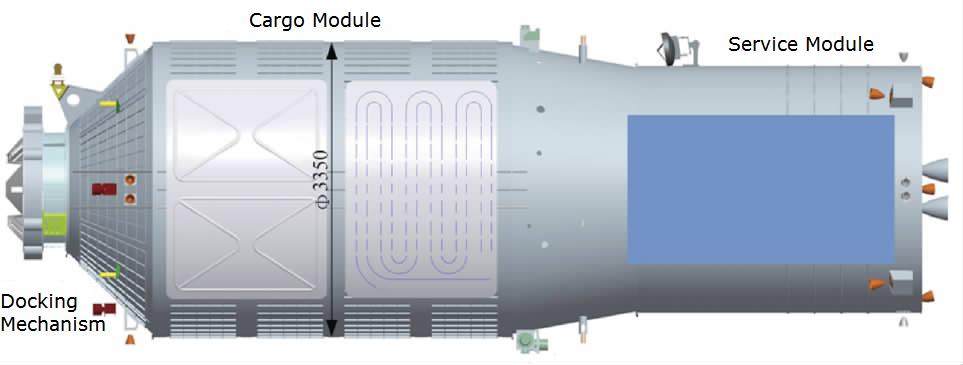
At the other end, a frontal hatch with a 0.8 m (~2.6 ft) diameter uses an androgynous docking system. Its design is identical to the APAS 89 used both on the Mir station, as well as on the ISS. These cargo capsules dock in a complete automatic manner, using optical and laser systems for the process. In this way, these systems enhance the readings from the radar during the approach.
Recent Upgrades
At launch, it now has a mass of about 13,500 kg (~30,000 lbs), of which ~7,400 kg (~16,400 lbs) comprise cargo. Tianzhou-6 is the first of a new batch of spacecraft going up to the eleventh one. These represent an improved design compared to the previous batch: TZ-3 to TZ-5. That is, the pressurized volume grew from 18.1 m3 (~640 ft3) to 22.5 m3 (~790 ft3). This implies an increase of about 20 % in volume for cargo capacity. In this way, it allows for the payload mass to reach the reported value, which before was ~6,900 kg (~15,300 lbs).
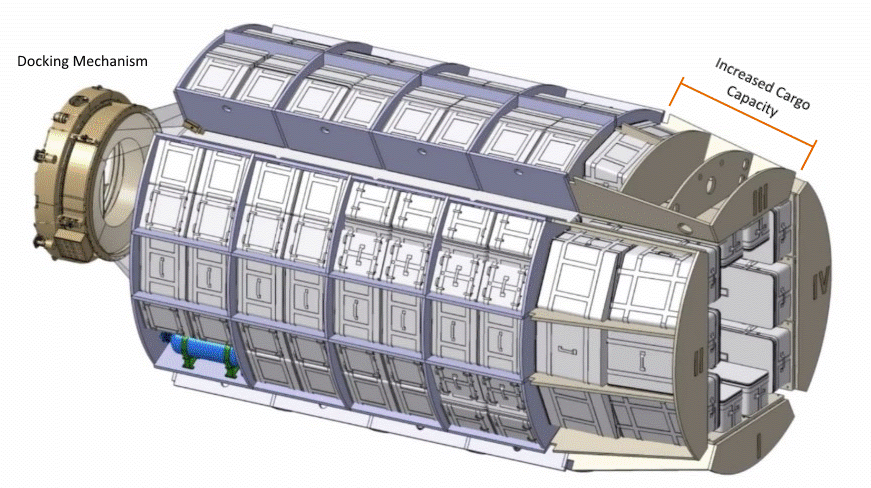
To achieve this, the engineers moved some devices previously mounted in the cargo module, and placed them in the service module. Thus, the conical section of Tianzhou can now be filled with cargo. The cargo module became longer in comparison to the service module, though the spacecraft’s total length remained the same. Additionally, some communication antennae also saw modifications. Because of these changes, Tianzhou-6 was the only logistics launch for the CMSA during 2023. Moreover, this ship became the most capable space freighter in service, allowing it to launch only three TZ capsules every two years. As a result, this enables the agency to perform more cost-efficient operations.
Previous Tianzhou Missions
For a list of these, as well as of the Long March 7’s flights, refer to the end of the article.
What Is The Long March 7?
A Brief History Of The New Long Marches
Like many other programs in the spaceflight world, the Chinese space program builds up on heritage knowledge and hardware from the defense sector. Examples of this are the veteran rockets in the family, namely the Long March 2, 3, and 4 — these still have active variants — which derive from the Dong Feng 5 intercontinental ballistic missiles (ICBM).
After decades in service, these hypergolic-propelled launch vehicles are finally, though slowly, heading for retirement. In their stead, a program was delineated to develop and manufacture a new generation of rockets purely conceived with only space applications in mind. This enterprise was assigned to the China Academy of Launch Vehicle Technology (CALT).
Aiming to develop flexible launchers, utilizing more advanced technologies, avoiding the use of highly toxic propellants, and following modularization criteria, the Long March 5 (LM-5) was envisaged, and a series of supplementary vehicles: the Long March 6, 7, and 8. Through the implementation of stages in three basic diameters — 5 m (16.4 ft), 3.35 m (~11.0 ft), and 2.25 m (~7.4 ft) — housing liquid-fed engines specifically developed for this plan, the newcomers were brought forth.
The Long March 7
Among the younglings, it was the LM-6 that first came into active service, followed about nine months later by its bigger brother: the LM-7. The 长征七号, or Chang Zheng 7 (CZ-7) in its anglicized form, first flew on June 25, 2016 (four months later, the LM-5). This launcher is a two-stage medium-lift expendable launch vehicle.
This rocket is on a path to take over most of the launch activity carried out by the older Long Marches. In the future it should perform both cargo and crew launches supporting China’s manned program, as well as commercial flights. However, so far its launch cadence is far lower than that of the veteran launch vehicles it seeks to replace.
Tiangong has benefited from the services of the Long March 7, as the latter was designed minding the capability of transporting the Tianzhou spacecraft. Through them, construction of the orbiting station has been possible as these cargo missions provided many necessary items for the task.
Long March 7’s Specifications
| Stages | 2 (3 optional) |
| Propellant | Kerolox (all stages) |
| Lift-off mass [kg (lb)] | 597,000 (~1,327,000) |
| Lift-off thrust [kN (lbf)] | 7,200 (~1,620,000) |
| Length [m (ft)] | 53.1 (~174) |
| Diameter [m (ft)] | 3.35 (~11) |
| Fairing length [m (ft)] | 13 (~43) |
| Fairing diameter [m (ft)] | 4.2 (~14) |
| Mass to LEO [kg (lb)] | 14,000 (~31,100) |
| Mass to SSO [kg (lb)] | 5,500 (~12,200) |
| Mass to GTO [kg (lb)] | 7,000 (~15,500) |
Side Boosters
Each booster consists of a single YF-100 engine, installed in a module with a diameter of 2.25 m (~7.4 ft) and a length of about 26.9 m (~88 ft). It presents a total mass of 81,500 kg (~181,000), while it generates a thrust of 1,200 kN (~268,000 lbf), and it burns with an Isp of 300 s.

As a fun fact, the CZ-7A has an unusual trait, as all of the boosters and the core form a single stage. Such a design feature was considered a good option to reduce the amount of impact points after staging over land — even when for the time being it is only launched from Hainan Island.
First Stage
The first stage consists of the center core, which is 3.35 m (~11 ft) in diameter and 25.1 m (~82 ft) in length. It presents a total mass of about 186,500 kg (~414,000 lbs). In order to power it, two kerolox — meaning kerosene and liquid oxygen — oxygen-rich staged-combustion-cycle YF-100 engines reside at the aft end of its fuselage. These produce roughly 2,400 kN (~540,000 lbf) of thrust and burn with a specific impulse (Isp) of 300 s.
As mentioned, at lift-off, the first stage together with the side boosters generate a thrust of about 7,200 kN (~1,620,000 lbf). Originally, there were plans for having variants with less thrust by reducing how many boosters are strapped to the core to two, or even none. However, to this day, both the 7 and the 7A variants have presented four boosters.
Second Stage
This one is also 3.35 m (~11 ft) in diameter, but its length is about 15.4 m (~51 ft). It totalizes a mass of 70,500 kg (~157,000 lbs), and it houses four kerolox oxygen-rich staged-combustion-cycle YF-115 engines. Each engine produces 176.5 kN (~39,700 lbf) of thrust — resulting in a combined value of 706 kN (~158,700 lbf) — has an ISP of 341.5 s, and a chamber pressure of 117 bar.
Upper Stage, Yuanzheng 1A
The optional upper stage of the Long March 7, 远征一号甲A — Yuanzheng 1A (YZ-1A), or Expedition 1A — is an enhanced version of the YZ-1. CALT developed it in order to increase its lifetime to 48 h (from a previous 6.5 h) and make it capable of 20 relights. This stage has its own flight computer, enabling it to inject payloads into different orbits. The YZ-1A even presents an option to be refilled with propellant in orbit. After finishing its mission, the YZ-1A deorbits itself, avoiding, in that way, the generation of further space debris. This stage runs on UDMH / N2O4, and has a singular YF-50D engine.
Wenchang And Yao 8
All of the Long March 7 and the 7A rockets are launched from the Wenchang Space Launch Site. This facility is managed as a site belonging to the Xichang Satellite Launch Center, therefore the difference in the structure of the name. This is, otherwise identical for the remaining two other centers — the Jiuquan Satellite Launch Center and the Taiyuan Satellite Launch Center. Wenchang offers two launch complexes: no. 1, for the Long March 5 and 5B vehicles, and no. 2, for the Long March 7 and 7A. Each of them is host to only one pad, hence the abbreviated designation LC-201 for the latter.
Official reports indicate that this rocket’s identification, or serial number, is Y8 or Yao 8. Because of this we know this rocket is the eighth Long March 7 produced. Conversely, the CZ-7As have their own series of identification numbers. For Tianzhou-7’s flight, the vehicle is assembled in the two-stage configuration. As a result, no upper stage is present, identically to every other CZ-7, with the exception of the one launched for its maiden flight.
Latest Long March 7’s Flights
| Serial # | Date, Time UTC | Payload |
| Y3 | May 29, 2021, 12:55 | Tianzhou-2 |
| Y4 | September 20, 2021, 07:10 | Tianzhou-3 |
| Y5 | May 9, 2022, 17:56 | Tianzhou-4 |
| Y6 | November 12, 2022, 02:03 | Tianzhou-5 |
| Y7 | May 10, 2023, 13:22 | Tianzhou-6 |





